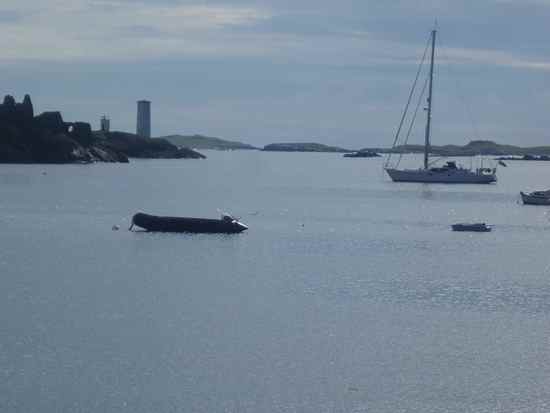Roundstone and Inishboffin

|
Roundstone
When we were planning this cruise, we were advised by more than one person that the best of Ireland was the South West Coast, the fingers that stick out into the Atlantic. We organised the cruise accordingly and have had a lovely time, dawdling along making thirty or so miles a day to the next port or anchorage and enjoying quality shore time. As we have moved further north, we have met fewer and fewer cruising yachts, but the ones we have come across have been ‘old hands’ and have told us of numerous places going north that we mustn’t miss, including advice on the best restaurants along the way. Unfortunately, we have planned long legs from here, generally arriving late and leaving early in the morning, the main aim being to avoid overnight passages. Once we had got back to the boat after our drenching in the trap , dried off, warmed up and the sun had come out again, we decided that we could make North 25 miles that afternoon to Roundstone, one of the recommended ports. An added incentive was that there was a good wind from the right direction, and we at last had a good sail rather than another tedious motor. Roundstone is described in the guide book as one of the gems of Connemara, and it is very pretty indeed, with colourful painted houses lining the old harbour. Across the bay the mountains of Connemara form an impressive back drop. It is possible to anchor in the harbour itself, but there is quite a shallow bar to negotiate, and we didn’t want to be trapped there in the morning, so picked up a visitors mooring outside in the bay. This was initially quite rolly, but flattened out as the tide went out, so we got a reasonable night’s sleep.
We dinghied ashore, and enjoyed a pleasant walk along the village’s main street, which has a number of general stores, craft shops and cafes. The recommended restaurant, O’Dowds, is right across the road from the little harbour. We were fully catered for our passage to Scotland, so didn’t really feel able to have a full evening meal there. We did however treat ourselves to a starter of crabs’ claws, which was absolutely delicious. This was followed on the boat by an almost equally delicious tarragon chicken. We had a few hours the next morning before we had to leave. We had the usual problem of disposing of our rubbish. We were directed to the recycling centre, which was no good at all, and threatened a €3000 for dumping. As luck would have it, it was dustbin collection day, so everyone’s dustbins were placed at the roadside and our bag was discreetly slipped into one. This done, we walked out to visit the workshop of a bodhran maker. The workshop side of the enterprise was interesting, but was attached to a large shop of tourist tat and an equally large group of German tourists who had arrived in a fleet of camper vans. The next leg of our journey was 28 miles to Inishbofin, a small island North of Slyne Head, another formidable headland. There is nothing particularly remarkable about Inishbofin itself, apart from the impressive remains of a fort on the headland leading into the harbour, which we found out had been built as a barracks by Cromwell. The entrance is not without its dangers, and you really need to use the leading lights and keep right over to the right, within feet of the rocks at the entrance in order to be sure of being in the channel. Keeping in the white sector going in, and lining up the leading marks was relatively easy going in. Somehow coming out, it seemed much more difficult to know which way to steer to keep everything in line.
We went on a circular walk which took us round to the north west side of the island. The place is actually pretty scruffy. A lot of new houses have been built, or are half built, alongside the roofless ruins of the original dwellings, giving the place the feel of a deserted village, combined with a building site. Even further out into the country, the fields are fenced with broken down, rusty fencing and are strewn with abandoned cars, broken down farm machinery, baths, lavatories and other paraphernalia. The north coast was wilder and more attractive, but as a holiday destination, it all felt a bit run down. The guide book says that as there are no garda on the island there is ‘good craic’ in the bars at night. As we needed to pack the dinghy away for an early start the next morning, we had to forgo the pleasures of the ‘craic’ which didn’t seem very likely in any case. |



